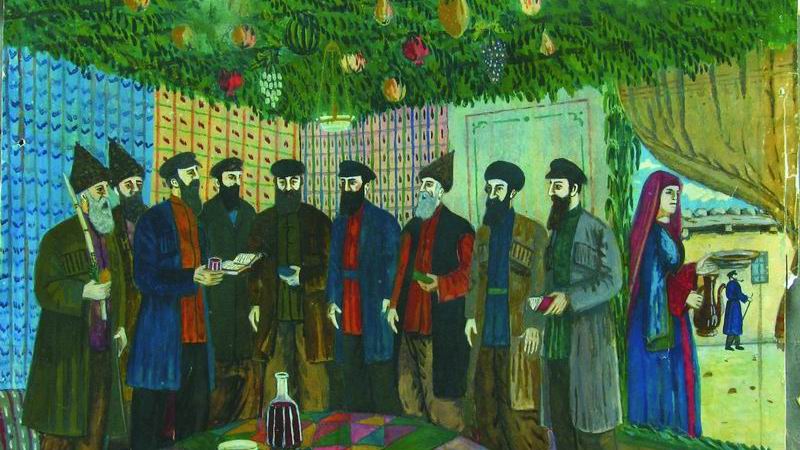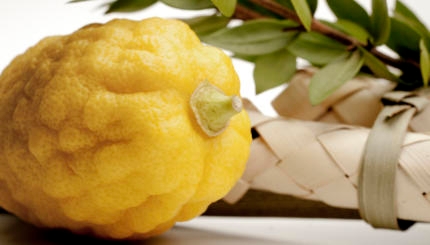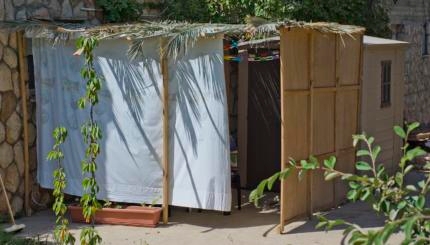Following on the heels of the High Holidays, the holiday of Sukkot represents a shift from somber reflection to joyous celebration, and from introspection to an outward display of thanks for the earth’s bounty. Unlike the High Holidays that precede it, Sukkot is a seasonal agricultural holiday and one of the three pilgrimage festivals.
Living in Booths
According to the Torah, on this holiday we should “live in booths (sukkot) seven days…in order that future generations may know that I made the Israelite people live in booths when I brought them out of the land of Egypt, I am the Lord your God” (Lev. 23:42-43). These “booths,” therefore, are a visible symbol of God’s beneficence, one that has its origins in the agricultural tradition. We view Passover not only as a commemoration of the redemption of the people from Egypt, but also as a time of planting. In a similar manner we view Shavuot not only as the time of the giving of the Torah, but also as the season of the first harvest. Like them, Sukkot is understood as Hag Ha’asif–“the holiday of the ingathering” of the harvest.
The booths that characterize the holiday may originally have been temporary structures that people would have used while taking in the harvest. Exodus 23:16 explains this connection: “…and the feast of ingathering at the end of the year, when you gather in the results of your work from the field”– it is a holiday of great joy, on which we celebrate the great bounty that God has given. The centrality of this holiday is even more apparent in biblical texts such as Nehemia, Ezekiel, and I Kings, where Sukkot is referred to simply as Hahag–“The Holiday.”
The holiday became known as a time to celebrate other great events; for example, Solomon’s Temple was consecrated on Sukkot. Even Hanukkah, another re-dedication of the Temple, was really a celebration of Sukkot that was likely moved back due to the political situation during the Sukkot’s normal season.
The booths, sukkot, which have lent their name to the holiday, have a somewhat hazy origin. According to the verse quoted above from Leviticus 23, we are to dwell in these booths because our ancestors lived in booths when God brought them out of Egypt. This is, however, the only reference we have relating the Exodus narrative to these temporary dwellings, leading scholars to speculate that the holiday’s connection to the Exodus developed rather late.
In rabbinic literature, much attention is given to these temporary dwellings. Extensive discussion on the nature and construction of a proper sukkah has helped shape Sukkot into the holiday it has now become, which is very much centered on the construction, decoration, and meaning of the impermanent structures we are told to make our homes for one week of the year.
The Four Species
Another well-known Sukkot tradition is that of the four species (arba’ah minim), also known as the lulav and etrog. “On the first day you shall take the product of hadar trees (traditionally identified as the etrog/citron tree), branches of palm trees, boughs of leafy trees, and willows of the brook, and you shall rejoice before the Lord your God seven days” (Leviticus 23:40). Certainly these gathered species must be a symbol of the agricultural aspect of the holiday–emphasizing four different types of growing things.
Indeed, these four species (while the lulav is a palm, it also refers to the whole bundle that includes the willow, myrtle and, sometimes, the etrog) are ones that specifically grow in Israel, which makes Sukkot a natural tie-in to the land, its agricultural rhythms, and by rights, a fitting time to celebrate national events that also celebrate the land, such as the Temple’s dedication. In Nehemiah 8, we find another tradition for the four species, including olive branches instead of willow branches, as is specified in Leviticus. We are also told that the people would cover the booths with these plants.
By the rabbinic period or even earlier, however, it is clear that the waving of the Four Species had become a commandment that is separate from that of the construction of the sukkah. The lulav and etrog also became symbols of the land. This can be deduced from coins that have been found from the time of the Bar Kochba revolt (132-135 CE), on which pictures of the lulav and etrog were found.
Today’s practice is to use the lulav and etrog every day during the Hallel (psalms of praise) and during the Hoshanot— hymns recited every day of Sukkot as we circle the synagogue, holding our lulav and etrog while singing the refrain hoshanah, “save us.” This is based on similar processions that took place when the Temple was still standing. The lulav has continued to be a poignant physical symbol following the period of intense spiritual reflection during the High Holidays.
Hoshanah Rabbah
Hoshanah Rabbah, the “Great Hoshanah” at the end of the holiday, on which people beat the willows, also represents the ultimate end to the period of teshuvah (repentance), at which point the very last decrees are issued from heaven. The custom of beating the willows has its origins in Temple ritual, where people would beat the willows on the floor near the altar in a symbolic destruction of sins.
When the Temple was still standing, there was a water libation that was performed only on Sukkot. It became a very joyous celebration known as Simchat Bet Hashoevah, at which festive performances took place. Today, some use this as a time to hold a party, or to have performances in their sukkot (the plural of sukkah).
With your help, My Jewish Learning can provide endless opportunities for learning, connection and discovery.
etrog
Pronounced: ETT-rahg, Origin: Hebrew, a citron, or large yellow citrus fruit that is one of four species (the others are willow, myrtle and palm) shaken together as a ritual during the holiday of Sukkot.
lulav
Pronounced: LOO-lahv (oo as in boo), Origin: Hebrew, a bundle of branches representing three species -- willow, myrtle and palm -- which are shaken together with the etrog on Sukkot.
sukkah
Pronounced: SOO-kah (oo as in book) or sue-KAH, Origin: Hebrew, the temporary hut built during the Harvest holiday of Sukkot.
Sukkot
Pronounced: sue-KOTE, or SOOH-kuss (oo as in book), Origin: Hebrew, a harvest festival in which Jews eat inside temporary huts, falls in the Jewish month of Tishrei, which usually coincides with September or October.


